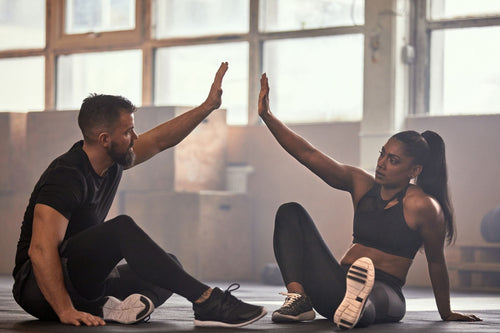In the competitive world of sports, mastering professional recovery techniques is crucial for athletes aiming to achieve peak performance. Understanding the pivotal roles of hydration, nutrition, sleep, and innovative recovery modalities can drastically enhance the recovery process. This blog will delve into essential recovery strategies, as well as the significance of mental resilience in the athletic journey.
The Athlete's Guide to Optimal Recovery
How Does Proper Hydration Influence Recovery?
Maintaining proper hydration is essential for athletes, as it plays a crucial role in the recovery process. Dehydration can impair various physiological functions, leading to decreased performance and delayed recovery.
Proper hydration supports the body's ability to replenish fluids, electrolytes, and nutrients lost during exercise. It aids in flushing out metabolic waste, reducing inflammation, and facilitating the delivery of oxygen and nutrients to muscle tissues.
- Dehydration can lead to muscle cramps, fatigue, and impaired cognitive function, all of which can negatively impact an athlete's ability to recover effectively.
- Optimal hydration helps regulate body temperature, which is essential for promoting muscle recovery and preventing further damage.
- Drinking the right amount of fluids, including water and electrolyte-rich beverages, can aid in the replenishment of glycogen stores, enabling the body to refuel and rebuild muscle tissue.
What Role Does Nutrition Play in Muscle Repair?
Proper nutrition is a critical component of the recovery process, as it provides the necessary building blocks for muscle repair and growth. Consuming the right mix of macronutrients and micronutrients can significantly enhance an athlete's ability to recover and perform at their best.
Adequate protein intake is essential for muscle repair and growth, as it supplies the amino acids required for the rebuilding and strengthening of muscle fibers. Carbohydrates, on the other hand, are crucial for replenishing glycogen stores and providing energy for the body's recovery processes.
- Protein-rich foods, such as lean meats, eggs, dairy products, and plant-based options like legumes and tofu, should be included in an athlete's diet to support muscle recovery.
- Carbohydrate-rich foods, including whole grains, fruits, and vegetables, can help restore glycogen levels and provide the necessary fuel for the body to repair and rebuild muscle tissue.
- Micronutrients, such as vitamins and minerals, play a vital role in supporting various recovery processes, from reducing inflammation to enhancing immune function.
Why is Sleep Vital for Athletic Performance?
Sleep is a fundamental aspect of the recovery process, as it allows the body to rest, repair, and rejuvenate. Adequate and quality sleep is essential for athletes to optimize their performance and enhance their overall recovery.
During sleep, the body enters a restorative state, facilitating the repair and growth of muscle tissue, the replenishment of energy stores, and the regulation of hormones that are crucial for recovery.
- Lack of sleep can lead to decreased muscle recovery, impaired cognitive function, and increased risk of injury, all of which can negatively impact an athlete's performance.
- Quality sleep helps regulate the body's circadian rhythms, which can influence factors such as hormone production, immune function, and metabolic processes, all of which are crucial for recovery.
- Establishing a consistent sleep routine and creating a sleep-conducive environment can help athletes achieve the necessary rest and recovery required for optimal performance.
How Do Compression Therapy and Cryotherapy Work?
Compression therapy and cryotherapy are two popular recovery modalities that can help athletes reduce inflammation, alleviate muscle soreness, and accelerate the recovery process.
Compression therapy involves the use of specialized garments or devices that apply graduated pressure to the limbs or body, helping to improve circulation, reduce swelling, and promote the removal of metabolic waste.
- Compression therapy can enhance the delivery of oxygen and nutrients to the muscles, aiding in the repair and regeneration of muscle tissue.
- It can also help to minimize the accumulation of lactic acid and other byproducts of exercise, which can contribute to muscle soreness and delayed-onset muscle soreness (DOMS).
Cryotherapy, on the other hand, involves the use of extreme cold temperatures to reduce inflammation and promote muscle recovery. This can be achieved through ice baths, cold water immersion, or specialized cryotherapy chambers.
- The application of cold temperatures can help constrict blood vessels, reducing blood flow and inflammation, thereby alleviating muscle pain and stiffness.
- Cryotherapy may also stimulate the release of endorphins, which can help to alleviate pain and promote a sense of well-being.
What Are the Benefits of Active vs. Passive Recovery?
Both active and passive recovery strategies can play a role in the overall recovery process, providing unique benefits for athletes.
Active recovery involves engaging in low-intensity physical activities, such as light jogging, cycling, or swimming, during the recovery period. This approach can help to increase blood flow, promote the removal of metabolic waste, and facilitate the delivery of oxygen and nutrients to the muscles.
- Active recovery can enhance the body's ability to replenish glycogen stores and promote the repair and regeneration of muscle tissue.
- It can also help to alleviate muscle soreness and stiffness, as the gentle movement can help to loosen up tight muscles and improve flexibility.
Passive recovery, on the other hand, involves resting and allowing the body to recover without any physical activity. This approach can help to reduce stress, promote relaxation, and allow the body to enter a parasympathetic state, which is essential for the recovery and repair processes.
- Passive recovery, such as stretching, foam rolling, or simply resting, can help to reduce inflammation and promote the body's natural healing processes.
- It can also help to improve sleep quality, which is crucial for overall recovery and performance.
Achieving the optimal balance between active and passive recovery strategies is essential for athletes to maximize their recovery and performance. By incorporating a comprehensive approach that addresses hydration, nutrition, sleep, and various recovery modalities, athletes can optimize their recovery and achieve their athletic goals.
Unlocking the Secrets of Mental Resilience for Athletes
What Techniques Can Athletes Use for Mental Resilience?
Mental resilience is a crucial aspect of athletic performance, as it allows athletes to overcome challenges, maintain focus, and perform at their best even in the face of adversity. In this segment, we will explore various techniques that athletes can utilize to build and strengthen their mental resilience.
Developing a Growth Mindset
- Cultivating a growth mindset, where challenges are seen as opportunities for learning and improvement, can be a powerful tool for building mental resilience.
- Athletes can practice self-reflection, analyze their mistakes, and focus on the lessons they can learn from setbacks, rather than dwelling on the failures.
- Embracing a growth mindset encourages athletes to take risks, experiment with new strategies, and persist in the face of obstacles.
Practicing Positive Self-Talk
- Positive self-talk, where athletes engage in encouraging and empowering internal dialogues, can help boost confidence and resilience.
- Athletes can learn to reframe negative thoughts, replace self-doubt with affirmations, and focus on their strengths and past successes.
- Consistent practice of positive self-talk can help athletes maintain a positive and focused mindset, even in high-pressure situations.
Building Strong Support Networks
- Surrounding themselves with a supportive network of coaches, teammates, and mental health professionals can provide athletes with the emotional and practical support they need to build resilience.
- Seeking out mentors, engaging in team-building exercises, and cultivating strong relationships can help athletes feel connected, understood, and empowered.
- Leveraging the expertise and guidance of mental health professionals can also be invaluable in developing personalized strategies for building mental resilience.
As athletes strive to unlock their full potential, mastering the art of mental resilience can be a game-changer. By cultivating a growth mindset, practicing positive self-talk, and building strong support networks, they can navigate the ups and downs of their athletic journey with greater confidence and success.
How Does Meditation and Mindfulness Impact Recovery?
The practice of meditation and mindfulness has gained significant attention in the world of sports, as athletes seek to enhance their physical and mental well-being. In this segment, we will explore how these techniques can positively impact the recovery process for athletes.
Reducing Stress and Anxiety
- Meditation and mindfulness practices have been shown to effectively reduce stress and anxiety levels, which can be particularly beneficial during the recovery process.
- By learning to focus on the present moment and regulate their emotional responses, athletes can better manage the mental and emotional challenges that often accompany injuries or setbacks.
- Consistent practice of these techniques can help athletes maintain a calm and centered state, enabling them to better cope with the demands of rehabilitation and the uncertainty of the recovery journey.
Enhancing Concentration and Focus
- Meditation and mindfulness can also improve an athlete's ability to concentrate and focus, which is crucial during the recovery process.
- By training their minds to stay present and attentive, athletes can better navigate the intricate details of their rehabilitation programs, ensuring they engage fully and effectively.
- Enhanced focus and concentration can also help athletes visualize their recovery goals, stay motivated, and maintain a clear and purposeful mindset throughout their journey.
Promoting Faster Physical Healing
- Emerging research suggests that meditation and mindfulness practices may also have a positive impact on the physical healing process.
- These techniques have been linked to reduced inflammation, improved immune function, and better pain management, all of which can contribute to faster recovery from injuries.
- By cultivating a state of relaxation and reducing the physiological stress response, athletes can create an optimal environment for their bodies to heal and regenerate.
Integrating meditation and mindfulness into their recovery routines can empower athletes to navigate the challenges of injury and setbacks with greater resilience, focus, and self-awareness. By harnessing the benefits of these practices, athletes can accelerate their physical healing and mental well-being, positioning themselves for a stronger comeback.
Why is Goal Setting Important for Mental Well-Being?
Effective goal setting is a crucial component of maintaining mental well-being and achieving success in sports. In this segment, we will explore the importance of goal setting and how it can positively impact an athlete's mental state.
Providing a Sense of Direction and Purpose
- Setting clear, achievable goals gives athletes a sense of direction and purpose, helping them stay motivated and focused on their desired outcomes.
- When athletes have a clear understanding of what they want to accomplish, they can direct their efforts and energy towards those specific objectives, rather than feeling lost or aimless.
- This sense of direction can be particularly valuable during challenging times, as it provides a roadmap for navigating obstacles and maintaining a positive mindset.
Enhancing Confidence and Self-Belief
- Achieving small, incremental goals can boost an athlete's confidence and self-belief, as they experience a sense of progress and accomplishment.
- As athletes systematically work towards their goals, they develop a track record of success, which can reinforce their belief in their own abilities and their capacity to overcome challenges.
- Increased confidence and self-belief can have a powerful impact on an athlete's mental well-being, as they approach their sport and life with a greater sense of self-assurance and resilience.
Promoting Adaptability and Resilience
- Goal setting encourages athletes to be adaptable and resilient in the face of setbacks or changing circumstances.
- When athletes encounter obstacles or unexpected challenges, they can re-evaluate their goals, adjust their strategies, and find alternative paths to success.
- This ability to adapt and persist in the pursuit of their goals can foster a growth mindset, enabling athletes to view challenges as opportunities for learning and improvement, rather than as insurmountable barriers.
By incorporating thoughtful goal setting into their mental well-being practices, athletes can cultivate a sense of purpose, build confidence, and develop the adaptability and resilience needed to thrive in the face of adversity. This holistic approach to goal setting can be a powerful tool in maintaining a healthy and fulfilling athletic journey.
How Can Visualization Techniques Improve Performance?
Visualization, also known as mental imagery, is a powerful tool that athletes can use to enhance their performance and mental well-being. In this segment, we will explore how visualization techniques can positively impact an athlete's overall success.
Enhancing Skills and Technique
- Visualization allows athletes to mentally rehearse and refine their skills and techniques, without the physical demands of on-field or court practice.
- By vividly imagining themselves executing specific movements or plays, athletes can reinforce neural pathways and muscle memory, leading to improved coordination, precision, and overall performance.
- This mental practice can be particularly beneficial for fine-tuning complex skills or for preparing for high-pressure situations where physical practice may be limited.
Boosting Confidence and Motivation
- Visualization can also positively impact an athlete's mental state, helping to boost confidence and motivation.
- By imagining themselves successfully completing a task or achieving a goal, athletes can cultivate a sense of self-belief and positive expectation, which can translate to increased determination and resilience during competition.
- Visualizing themselves overcoming challenges or performing at their best can help athletes maintain a focused and optimistic mindset, even in the face of adversity.
Promoting Emotional Regulation and Stress Management
- Visualization techniques can also be used to help athletes manage their emotions and cope with stress more effectively.
- By imagining themselves in high-pressure situations and practicing relaxation and focus strategies, athletes can develop better emotional control and the ability to stay calm and centered during competition.
- This emotional regulation can be particularly beneficial for athletes who struggle with performance anxiety or who need to maintain composure during critical moments.
Incorporating visualization techniques into an athlete's training and mental preparation can be a game-changer. By enhancing skills, boosting confidence, and promoting emotional regulation, these powerful mental tools can help athletes unlock their full potential and achieve their performance goals with greater consistency and success.
What Are the Psychological Effects of Injury Recovery?
Recovering from an injury can be a challenging and emotionally taxing experience for athletes, as they navigate the physical, mental, and emotional aspects of the healing process. In this segment, we will explore the psychological effects of injury recovery and how athletes can manage these challenges.
Dealing with Loss and Uncertainty
- Sustaining an injury can be a significant loss for athletes, as they are suddenly faced with the possibility of missing competitions, being separated from their teams, and experiencing disruptions to their athletic routines.
- This sense of loss, coupled with the uncertainty surrounding the recovery timeline and potential long-term consequences, can lead to feelings of anxiety, depression, and frustration.
- Athletes may struggle to cope with the disruption to their athletic identity and the fear of not being able to return to their previous level of performance.
Maintaining Motivation and Resilience
- The recovery process can be a long and arduous journey, requiring consistent effort and dedication from the athlete.
- Maintaining motivation and resilience during this time can be particularly challenging, as athletes may experience setbacks, plateaus, or a sense of stagnation in their progress.
- Developing strategies to stay focused on their goals, celebrate small victories, and cultivate a growth mindset can help athletes navigate the ups and downs of the recovery process.
Reintegrating into the Team and Competition
- Once an athlete has completed their physical rehabilitation, they may face the psychological hurdle of reintegrating into their team and returning to competition.
- Concerns about performance, acceptance from teammates, and the fear of re-injury can create significant mental barriers that must be addressed.
- Incorporating gradual exposure, visualization, and communication with coaches and teammates can help ease the transition and build the athlete's confidence in their ability to perform at their best.
Navigating the psychological effects of injury recovery requires a multifaceted approach that addresses the emotional, motivational, and reintegration challenges faced by athletes. By developing coping strategies, maintaining a growth mindset, and seeking support from coaches, teammates, and mental health professionals, athletes can emerge from the recovery process stronger, more resilient, and better equipped to achieve their athletic goals.
Unlocking the Future: How Wearables Are Transforming Recovery Tracking
How Are Wearable Devices Revolutionizing Recovery Tracking?
In the ever-evolving world of sports and fitness, the impact of wearable technology has been nothing short of revolutionary. These innovative devices have become indispensable tools for athletes and fitness enthusiasts, providing unprecedented insights into their bodies' responses and recovery processes.
Wearable devices have become the new frontier in recovery tracking, empowering individuals to take a more proactive approach to their physical well-being.
- Sophisticated sensors embedded in these wearables can continuously monitor a wide range of physiological data, including heart rate, sleep patterns, and even muscle activity, providing a comprehensive understanding of the body's recovery status.
- By analyzing this real-time data, athletes and fitness enthusiasts can make informed decisions about their training regimens, ensuring they optimize recovery and minimize the risk of injury.
- The ability to track recovery metrics through wearables has also enabled more personalized and data-driven rehabilitation programs, tailored to the unique needs of each individual.
What Innovations Are Emerging in Recovery Tools and Equipment?
Beyond the realm of wearable devices, the sports and fitness industry has witnessed a surge of innovative recovery tools and equipment designed to accelerate the healing process and enhance overall well-being.
From cutting-edge compression garments to state-of-the-art massage devices, the landscape of recovery tools is constantly evolving, offering athletes and fitness enthusiasts a wide array of solutions to support their post-workout needs.
- Compression garments, such as sleeves, tights, and socks, have become increasingly popular among athletes, as they have been shown to improve blood circulation, reduce muscle soreness, and enhance recovery times.
- Massage devices, including handheld percussion tools and full-body massage chairs, have revolutionized the way individuals can access targeted massage therapy, promoting muscle relaxation and reducing inflammation.
- Cryotherapy chambers and ice baths have emerged as cutting-edge recovery modalities, leveraging the power of extreme cold to reduce inflammation, alleviate pain, and accelerate the body's natural healing processes.
How Can Virtual Reality Aid in Recovery Processes?
The integration of virtual reality (VR) technology into the realm of recovery has opened up a new frontier of possibilities, offering innovative solutions to enhance the rehabilitation experience.
VR-based recovery programs are redefining the way individuals approach their physical and mental well-being, providing immersive and engaging experiences that can promote faster healing and improved overall outcomes.
- VR-powered rehabilitation programs can simulate real-world environments, allowing individuals to engage in interactive physical activities and exercises within a safe and controlled setting, thereby facilitating the relearning of motor skills and the rebuilding of muscle strength.
- By providing engaging and visually stimulating experiences, VR can also aid in the management of pain and discomfort, distracting the mind from the physical challenges of the recovery process and promoting a more positive and resilient mindset.
- Integrating VR with biofeedback technologies can further enhance the recovery experience, providing users with real-time data on their physiological responses and enabling them to better understand and optimize their rehabilitation efforts.
What Role Does Artificial Intelligence Play in Personalized Recovery Plans?
As the world of sports and fitness continues to evolve, the integration of artificial intelligence (AI) has emerged as a powerful tool in the realm of personalized recovery planning.
AI-driven recovery solutions are revolutionizing the way individuals approach their post-workout needs, offering customized strategies that cater to their unique physiological and behavioral characteristics.
- By analyzing vast amounts of data from wearable devices, training logs, and medical records, AI-powered algorithms can identify patterns and trends, enabling the development of personalized recovery plans that address the specific needs of each individual.
- These AI-driven recovery plans can incorporate a wide range of modalities, from targeted exercise routines and nutrition recommendations to sleep optimization strategies and stress management techniques, all tailored to the user's unique recovery profile.
- The integration of AI can also facilitate the ongoing monitoring and adjustment of recovery plans, continuously adapting to the individual's changing needs and ensuring the most effective and efficient path to optimal recovery.
Which Recovery Apps Are on the Rise Among Athletes?
In the ever-expanding digital landscape, the emergence of specialized recovery apps has revolutionized the way athletes and fitness enthusiasts approach their post-workout needs.
These innovative mobile applications are empowering individuals to take a more proactive and data-driven approach to their recovery, providing a comprehensive suite of tools and resources to support their physical and mental well-being.
- Recovery-focused apps offer a wide range of features, from automated workout and nutrition planning to personalized sleep tracking and mindfulness exercises, all designed to optimize the body's natural healing processes.
- Many of these apps seamlessly integrate with wearable devices, allowing users to sync their physiological data and receive real-time insights and recommendations tailored to their recovery needs.
- The rise of community-driven recovery apps has also fostered a sense of camaraderie and accountability, enabling athletes and fitness enthusiasts to connect with like-minded individuals, share experiences, and learn from one another's recovery journeys.
The world of recovery is undergoing a transformative shift, driven by the convergence of cutting-edge technologies and a deeper understanding of the human body's intricate recovery mechanisms. From wearable devices that provide unprecedented insights to innovative recovery tools and the integration of virtual reality and artificial intelligence, the future of recovery is poised to empower individuals to take control of their physical and mental well-being, ushering in a new era of personalized, data-driven, and holistic approaches to post-workout recovery.
Q&A
How does proper hydration influence athletic recovery?
Proper hydration is crucial for recovering athletes as it aids in replenishing lost fluids and electrolytes while flushing out metabolic waste. It prevents muscle cramps and fatigue, regulates body temperature, and supports the delivery of nutrients to muscle tissues.
What role does nutrition play in muscle repair?
Nutrition provides the essential building blocks for muscle repair. Adequate protein intake is vital for rebuilding muscle fibers, while carbohydrates help replenish glycogen stores essential for recovery. Micronutrients also support various physiological functions important for recovery.
Why is sleep vital for athletic performance?
Sleep allows the body to repair and rejuvenate. Adequate sleep is crucial for muscle tissue growth, energy replenishment, and hormone regulation, vital for optimal recovery. Lack of sleep can impair performance and increase the risk of injuries.
How do compression therapy and cryotherapy aid in recovery?
Compression therapy enhances circulation, reduces swelling, and removes metabolic waste. Cryotherapy uses extreme cold to decrease inflammation and muscle pain. Both methods can alleviate soreness and expedite the recovery process.
What are the benefits of active recovery compared to passive recovery?
Active recovery involves low-intensity physical activities that improve blood flow and facilitate metabolic waste removal, promoting faster recovery. In contrast, passive recovery entails complete rest, which helps reduce stress and inflammation and promotes natural healing processes.
How can mental resilience techniques enhance athletic performance?
Mental resilience techniques such as developing a growth mindset, practicing positive self-talk, and building supportive networks can help athletes maintain focus, overcome challenges, and boost performance even in adverse conditions.
Incorporating effective recovery strategies ranging from proper hydration, nutrition, restful sleep, and advanced recovery modalities empowers athletes to excel in their performance. Emphasizing both physical and mental resilience enables athletes not only to recover from their workouts but also to thrive in their athletic journey. By embracing a holistic approach to recovery, athletes can unleash their ultimate potential.









